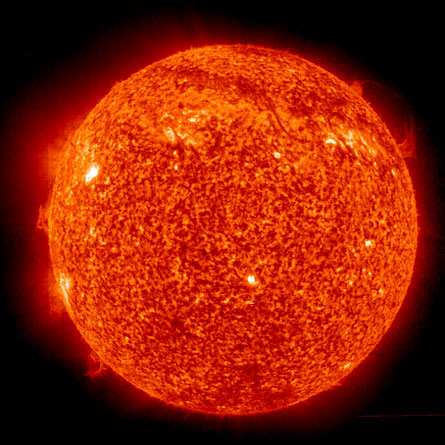
Newly reported observations of gas flows on the solar surface may explain why the sun recently had such an extended case of the doldrums.
From 2008 through the first half of 2009, the sun had a puzzling dearth of sunspots, flares and other storms, extending the usual lull at the end of the 11-year solar activity cycle for an extra 15 months. Findings from the study, which relied on the orbiting Solar and Heliospheric Observatory, or SOHO, may also suggest a better way to forecast the intensity and duration of future solar cycles.
Better predictions could be critical because some solar outbursts can blast Earth with massive, magnetized clouds of charged particles capable of knocking out electrical power grids and harming communications satellites.
In the March 12 Science, David Hathaway of NASA’s Marshall Space Flight Center in Huntsville, Ala., and Lisa Rightmire of the University of Memphis in Tennessee analyzed 13 years of SOHO measurements that tracked the movement of ionized gas from the solar equator to the poles. The researchers found that the relatively slow gas movement, known as the meridional flow, sped up a few years before the last solar minimum began in 2008. What’s more, the flow was substantially faster than the speed at the previous solar minimum, a more typical and less extended downturn in solar activity some 11 years earlier.
Hathaway and Rightmire suggest that the faster meridional flow produced weaker magnetic fields at the sun’s poles, which extended the solar minimum.
Magnetic fields carried by the meridional flow typically oppose much stronger flows of magnetized material on the surface, Hathaway says. The faster the meridional flow is, the greater the opposition is to those other flows. As a result, the sun’s polar magnetic field can’t become as strong, the researchers propose.
“It is possible that the delayed start of the present cycle, 2009 to 2010, was caused by the relatively weak polar field in 2007 to 2009,” comments Neil Sheeley of the Naval Research Laboratory in Washington, D.C.
The strength of the magnetic polar fields plays a critical role in determining the onset of the next solar cycle, Hathaway notes. These fields dive beneath the solar surface, building up the deep sunspot-generating magnetic fields that signal the beginning of the next solar cycle. Weaker polar fields take more time to reach the strength required to produce sunspots, prolonging the lull in activity from the previous cycle. In addition, weaker-than-usual polar fields are likely to produce less activity during the subsequent solar cycle, Hathaway and Rightmire predict.
“The fact that the meridional flow plays a key role in setting up the sun’s polar fields for the next cycle suggests that future observations will help us predict [the duration and intensity of] future cycles,” Hathaway says.
One caveat is that physicists have only an incomplete understanding of the solar cycle and the transport of magnetic material below the solar surface, Sheeley says.
“This is certainly an interesting result and may help discriminate between different classes of models of solar magnetism,” notes Natchimuthuk Gopalswamy of NASA’s Goddard Space Flight Center in Greenbelt, Md.
Other models, says Hathaway, which also embrace the importance of the meridional flow but rely on the complicated magnetic dynamics that happen below the surface, come to just the opposite conclusion: A fast meridional flow leads to strong polar field and a shorter solar minimum. Those models may now need to be revised, he says.
Magnetic flows and sunspot lows from Science News on Vimeo.
This video clip, narrated by solar physicist David Hathaway, explains the links between sunspots, solar magnetic fields and the sun’s outer atmosphere.
Credit: D. Hathaway







